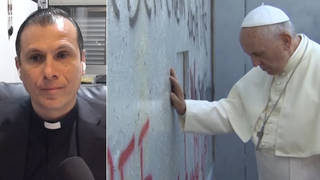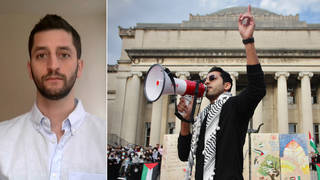
Amnesty International’s new report entitled “At Any Cost: The Civilian Catastrophe in West Mosul, Iraq” states the U.S. coalition may have committed war crimes in Mosul. We speak with Nicolette Waldman, co-author of the report and the Iraq researcher at Amnesty International.
Transcript
JUAN GONZÁLEZ: The journalistic monitoring group Airwars is reporting that the U.S.-led war against ISIS has killed at least a dozen civilians every single day since President Trump took office. Their investigation found U.S.-led coalition airstrikes and shelling in Iraq and Syria killed more than 2,200 civilians during Trump’s six months in office, a far higher rate of reported civilian casualties than under the Obama administration.
AMY GOODMAN: This comes as Amnesty International reports the U.S.-led coalition and the U.S.-backed Iraqi forces violated international law and may have committed war crimes during the battle to seize control of Mosul from ISIS. Lieutenant General Stephen Townsend, who oversees the campaign against ISIS in Iraq and Syria, has denied the U.S.-led coalition broke international law, claiming instead the campaign against ISIS is the, quote, “most precise campaign in the history of warfare,” unquote. Thousands of civilians were killed during the nine-month battle in Mosul, and nearly a million residents were forced to flee their homes.
For more, we go to Beirut, Lebanon, to speak with Nicolette Waldman, an Iraq researcher at Amnesty International, co-author of their new report, “At Any Cost: The Civilian Catastrophe in West Mosul, Iraq.”
Nicolette, welcome to Democracy Now! Talk about what you found.
NICOLETTE WALDMAN: Thank you. What we found is that both ISIS and the Iraqi and coalition forces inflicted massive harm on civilians during the battle for west Mosul. On the one hand, ISIS systematically moved thousands of civilians directly into areas of active fighting, and then they trapped them there. On the other hand, Iraqi and coalition forces then subjected these very same areas to relentless attacks. These attacks used explosive and imprecise weapons that killed and injured thousands of civilians and left the city flattened.
JUAN GONZÁLEZ: And, Nicolette, were you able to interview people in both east and west Mosul? And what were some of the things that they told you directly, the civilians in—trapped in these zones?
NICOLETTE WALDMAN: This report focused only on the battle for west Mosul. And we had covered the battle in east Mosul in previous outputs. But this report really focused in on the battle that took place between February and then just ended officially days ago. And for this research, we visited west Mosul, we visited east Mosul, and then we talked to people in camps around the city who had fled either days or weeks before we spoke with them.
And what they told us was that this battle was horrific. Basically, they had been rounded up and forced into the battle, and then they had no way out. And what actually happened for so many people is that because they were forced to move into the city, and then, as the battle continued, they were forced to fall back, so as the front lines went back, the civilians moved back with those front lines. And the area in west Mosul became increasingly packed with civilians. So, because ISIS was preventing people from escaping, this meant that they only had one way out, in most cases, and that was directly through the front lines of the battle. And what people told us time and time again is that they didn’t wait for the battle to subside or the fighting to calm down. Instead, they waited for the fighting to actually reach its peak, and that was the moment when they ran out into the middle of the street, usually. They would sit down, they would raise their hands, and they would say, “Civilians, families,” and sit and wait for the Iraqi forces to motion them forward. Only then would they literally make a run for it and make it out of this battle. So, the cost to civilians was extremely high. And really, what we want to do with this report is to bring attention not to the victory that so many are talking about in the last few days, but to the tremendous cost that civilians suffered during this battle.
AMY GOODMAN: Speaking to NPR Thursday, Air Force Brigadier General Andrew Croft responded to the findings of your report, of the Amnesty report.
BRIG. GEN. ANDREW CROFT: I think it’s an unfair accusation. They have not coordinated with the coalition. I’ll tell you that from the way we do our airstrikes, we use the most precise and discriminate weapons we can ever use and are available in the world to avoid targeting civilians. And I’ll tell you, if there’s ever a doubt of whether or not there’s a civilian involved, we will not strike. And so, this is the most precision, low-collateral level of warfare, especially in an urban environment like this, which has not been seen since World War II, that you could ever construct. And so, we have done, in my view, the absolute best job we can to avoid any civilian casualties. They’re going to happen, just based on the nature of the war. But I can tell you that to be effective, we’ve got to support the Iraqi security forces, and that’s what we’ve done.
AMY GOODMAN: Nicolette Waldman, can you respond to Air Force Brigadier General Andrew Croft?
NICOLETTE WALDMAN: That is not what we found on the ground. And basically, we spent weeks sitting with families, talking to them. And it seemed as if, to me, every third family we talked to had lost a family member in one of these Iraqi and coalition air force airstrikes or ground attacks. And it was actually so common for people to be full of shrapnel—I met whole families who were full of shrapnel—that they wouldn’t even seek medical attention.
So, to his claims that this was the most precise campaign in the history of warfare, I would respond just with my experience with the civilians’ experience of what they went through, and basically would call on the Iraqi and coalition air forces to use their great technological advantages to better affect—to better protect civilians in places such as west Mosul, because what we found was quite the contrary. We found that Iraqi forces, in particular, were consistently using IRAMs, improvised rocket-assisted munitions. These are basically flying IEDs. They have a massive warhead, and they cannot be precisely targeted. So these were being flung into neighborhoods where people were trapped, where they had no way out, and where often people were packed in one house between groups of—groups between 15 and a hundred civilians. So, when this type of imprecise—these weapons that cannot be targeted are launched into areas like this, the cost is going to be high. And we would call on the U.S. and Iraq coalition, the coalition and Iraqi forces, to do better in the future, to prioritize civilian protection and to uphold their obligations under international humanitarian law, which requires them not to use the type of weapons they did, these imprecise explosive weapons, in these very densely populated areas.
JUAN GONZÁLEZ: And what did you find out about the reports from the coalition forces that ISIS was using civilians as human shields? How prevalent was that, from what you were able to find out?
NICOLETTE WALDMAN: It was absolutely prevalent, and to a scale even we didn’t expect. What was happening is they weren’t just using humans as shields to protect their own forces. They were moving people in to the battle. So starting in even the months before the battle for west Mosul started, they rounded up civilians in buses, in trucks, and forced them sometimes to move by foot, by the thousands. So they moved them into west Mosul. Then, once they were there, they moved them back and kept them with them from neighborhood to neighborhood. So this could have been one of the most prevalent use of human shields, or using civilians just protect their own forces, in modern history.
And what happened then, as well, is they didn’t just put them into this amazing risk. They kept them there so that people who would try to escape and save their own lives would be executed by snipers as they were running to safety. And then the bodies of these people would be hung by ISIS in public areas as a warning for those who might just consider trying to escape. So this meant that people could not escape. And in some cases, not just here or there, but again and again, we heard that people were being welded into their houses. So the front doors were actually being welded together. We heard that people had booby traps set in the exits of their houses so they could not leave. This meant that huge groups of civilians were sheltering in these homes and being used as human shields in such an egregious way and a deliberate away.
But then what was happening is these very same areas, where these people were trapped, these areas were being barraged by air attacks and ground attacks by the Iraqi and coalition forces. And what we found was that most attacks weren’t actually killing the high numbers, of attacks like the Mosul al-Jadida attack on March 17th. Instead, they were killing between one and 20 civilians. And most of these deaths will actually go unnoticed and, so far, have not been acknowledged, because, actually, in Mosul, in west Mosul, ISIS had completely banned the use of mobile phones. And they don’t have the kind of infrastructure to rescue people to actually go after and document these deaths. So what we found when we were doing this research is that the scale of death was much, much higher than has so far been acknowledged. And Airwars, who you mentioned just at the beginning of your show, estimated that between just February 2017 and June 2017, as many as 6,800 people were killed in attacks by the Iraqi and coalition forces. And just during our research, so during the 151 interviews that we conducted with west Mosul residents, we documented 45 unlawful attacks. And these attacks killed at least 426 civilians and injured 100. So the scale of suffering and the scale of death and injury has really not been grappled with yet. And I’m afraid we’ll be finding out in the months and the years to come of the true toll of this operation.
AMY GOODMAN: Nicolette Waldman, we want to thank you for being with us, Iraq researcher at Amnesty International, co-author of the new report, which we’ll link to, “At Any Cost: The Civilian Catastrophe in West Mosul, Iraq.”
When we come back, Life on Parole, a new Frontline documentary that airs tonight on PBS looking at how states are trying to reduce their prison population by putting more people on parole. We’ll meet some of the former prisoners as they navigate challenges of their first year on parole, and speak with the director and The New York Times reporter behind the story. Stay with us.













Media Options